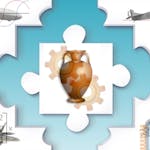Description
How is a satellite constructed? What kind of flight do they have? How do they communicate with one another, and how does the network work? All of the answers in this course will be provided by teachers and researchers from three schools affiliated with Institut Mines-Télécom. The course consists of instructional videos, equipment demonstrations, and simulation programmes. They will walk you through the process of learning about satellite communications. Professionals in the space industry will share a passion for this scientific and technological field. Have you ever wanted to learn more about transponders, geostationary orbit, QPSK modulation, channel coding, link budgeting, and TCP over large bandwidth x delay product links? This is the course for you! This course is offered in English: Lecturers in French with English subtitles and fully translated content (slides, practices). The Patrick and Lina Drahi Foundation is funding this MOOC.
Syllabus :
1. Satellites at our service
- Greetings, Earthling
- Learning in six weeks (or more, or less)
- The conques
- The challenges
- Going further: the Van Allen belt
- The first steps
- Communications capacity
- Communications satellites today
- Going further: communications capacity (the return)
- Strengths of satellites
- A variety of services
- Going further: positioning in networks
- Navigation
- Going further: space exploration
- Introduction & the market players
- Economic elements
- Nathalie Font - marketing
- Remi Lapeyre - spacecraft operations
2. Satellite and communications
- Introduction & a matter of segments
- A matter of links
- System engineering
- Laws of a space communication system
- Going further: managing multiple access by terminals
- Various types of orbit
- Relationship between orbit and service
- Going further: Kepler lays down the law
- The platform and its subsystems
- Payload: antennas
- Payload: repeater
- Going further: repeater for mesh architecture
- Patricia Iñigo Martinez - system engineering
- Nicolas Jacquey - payload engineering
3. Digital communications'
- Bit rate
- Bit error rate
- Bit rate / symbol rate
- Concept of frequency
- Bandwidth occupied by the signal
- Bandwidth / rate relation
- Carrier transmission
- Free space propagation
- Limited bandwidth
- Noise
- Mohamed Benseddik - regulatory affairs
4. Communication techniques
- BPSK modulation
- QPSK modulation
- QAM modulation
- PSK modulation
- Demodulation
- Bit error rate (BER)
- Repetition Codes
- Binary block codes
- The coding gain
- The impact of the code efficiency on the BER
- Bouchra Benammar - research and development
- Mathieu Dervin - research and development
5. Hardware and equipments
- Introduction & terminal types and general architecture
- Light terminals
- Portable, transportable and fixed terminals
- Mobile terminals
- Going further: functioning of an antenna with automatic pointing
- Introduction
- Antennas
- RF elements
- Frequency conversion and modems
- Interconnection with Earth
- Other aspects
- Going further: monitoring the health of the satellite
- Analog link budget
- The noise component
- The end-to-end budget
- Digital link budget
- Conclusion & Going further: other factors in the link budget
- Cynthia Fontana - satellite transmissions
- Hervé Gaudefroy - products and services development
- Internet by satellite
6. Networking and services
- Before the Internet
- Internet and the notion of network
- Interconnection and interoperability: a real issue
- The notion of protocol
- Going further: Internet Protocol and the hourglass
- From analog to digital
- DVB-S
- Evolutions
- Independent systems
- Globalstar vs Iridium
- Interconnection with mobile telephony networks
- Voice over IP
- Going further: Impact of a satellite link on QoS
- What are we talking about?
- Need for a return link
- IP over satellite: the challenges
- Sandrine Lafont - ground segments and services
- Alain Frizon - satellite programme









